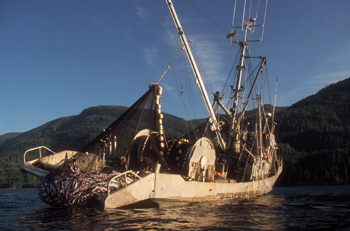Problems and Promises
by Jeff Della Penna
|
Just a year ago Maine’s Marine Resources Committee was struggling through the review of 13 different aquaculture bills, including proposals that would give municipalities veto power over future lease sites and regulations that would expand leasing criteria to include aesthetic, social and cultural impact. In the words of Sebastian Belle, executive director of the Maine Aquaculture Association, Maine aquaculture was “Caught in the cross-hairs,” — under fire from several commercial fishing organizations, local and national environmental watchdog groups, and property owners. In addition to the baker’s dozen of proposed bills designed to rein-in aquaculture, two of Maine’s bigger finfish companies (Stolt Sea Farm and Atlantic Salmon of Maine) were in court battles with an environmental group (U.S. Public Interest Research Group) over alleged violations of the federal Clean Water Act. And, aquaculture was also being called before the Board of Environmental Protection over pollutant discharge standards.
For those opposed to aquaculture, no matter what the complaint; be it loss of bottom, aesthetics, pollution, disgruntlement over foreign ownership, or the disappointment over the failure of aquaculture to provide the jobs and benefits that they had once promised, it looked like fish farms were on the run. “It’s very difficult when all you’re doing is fighting people sniping at you because they don’t think you’re a good crowd of folks,” Belle said.
|

Above a salmon purse seiner in Johnstone Strait, British Columbia, Canada. Traditional salmon fishing operations have found it more difficult to compete with farm raised salmon in the marketplace.
(Photo ©joelrogers.com) |
But, as Mainers are beginning to understand, in the big picture, aquaculture plays a major role and certainly Governor John Baldacci, the state’s legislators, or the Maine Department of Marine Resources (DMR) didn’t want to see aquaculture get run out of town. “Aquaculture is an important part of the State’s marine economy,” Baldacci said a year ago.
|
“However, the controversy that has surrounded aquaculture in recent years has impeded Maine’s ability to stand back and think comprehensively about aquaculture’s place on the coast.”
In an effort to get to the heart of the issues, the Marine Resources committee members “melded” six of the proposed 13 bills into one, identified as LD 1519, which
continue
|
|
Witch Indians Pray
by Mike Crowe
|
In the 1600’s Maine was a province of Massachusetts and described by some as “the best land in New England”. From the earliest days of settlement it was a source of timber, fish and fur. Maine provided the major source of revenue to the Massachusetts Bay Colony. The Gulf of Maine, thick with cod, dense virgin forests packed with towering mast pine and a beaver population little impacted by the natives, were the fuel of the country’s first economic engine. However, fish and fur had also been the basis of the native Indian’s economy, culture and survival.
Merchants in Massachusetts traded these products and a primary shipping point to European markets was Salem. There were about 400 boats fishing in the Gulf of Maine in the 1690’s. Sawmills were clustered at the mouths of some Maine rivers and fur traders had set up posts nearby. The northern frontier settlements were doing well almost from the beginning. Traffic between the resource-rich Maine frontier settlements and commercial Salem, Massachusetts was common.
continue
|

Native Americans were harpooning large fish in the inshore waters of the Gulf of Maine
long before the arrival of Europeans. Swordfish were among those taken. They also built
weirs and used nets and lines. Natives fished on and at the mouths of many rivers. Many
Maine tribes were identified by the names of the rivers they fished, traveled and farmed
along, — Sacos, Penobscots, etc. Settlers set up saw mills, fishing stations and farms in
choice locations. Access being blocked or taken over by European settlers was one of the
early points of contention between native Americans and the settlers.
Graphic – Indian New England Before the Mayflower, by Howard S. Russell.
|
|
  
|
|

